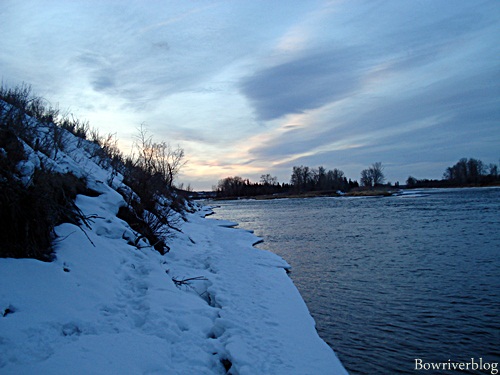Water temperatures and trout fishing
Most of us anglers are aware that the temperature of the water can either increase our chances or decrease them depending on water temperature. Winter is here in Alberta and the water is cold, not glacial yet but still quite cold. A generalization can be made for preferred trout temperatures. If we concur that 11C- 18C water temperature is the preferred range for trout fishing, we can then say that trout will react positively to temperatures changes that lean towards this preferred range. Thus, if the water temperature rises from 1C-6C, this rise will most frequently have a favorable effect on catching fish. Similarly with a change from 22C-17C will also have a favorable effect when trout fishing. In the summer you will see anglers fishing in the morning or later in the evening when the water temperatures drop. However a change from 12C -8C will have a negative effect on the fishing as will a change from 4C-0C. As you can see by the numbers, water temperature is often a relative factor that should be studied in relation to the immediate past history of the watershed you are fishing.
So what does a favorable temperature change do to the trout? It increases fish metabolism! If metabolism is higher the trout become more active and they will feed more. Temperature changes directed away from the preferred range will have a tendency to shock fish initially making them lay low and not feed. To summarize this point, a trout can adjust well to a drop in temperature of 7C from 11C but initially the trout will have to adjust. However, trout do not seem to need to adjust to temperature changes in the direction of the preferred range. They seem to become more energized which translates into good to excellent fishing! How does the above strategy tie into YOUR angling strategy? Very closely. It is always almost always warmer in the daytime than it is at night. Warm air warms the water while cool air cools the water. Because the water is always warming and cooling, there will be certain times of the day where the water will be either warmer or cooler in the direction of the preferred temperature range. It is at these times when angling will be at its best. (Note, this excludes extreme hot spells and cold fronts.)
Many anglers have been clichéd into believing that trout fishing is best in the early morning or late evening. This is true in many cases but is also untrue in many other cases. An example, a typical Alberta stream in August may cool down to 15C at night. Naturally if you fish at 5:00am when the water is at its coolest is going to make trout more active since 15C is within their ideal range. When the water warms up at noon to 20C, the fish become lethargic, taking little interest in whatever you are chucking at them. As the hot sun sets in the west, the waters begin to cool and the fish once again become active and feed!
As mentioned above, trout do not have a lower end temperature threshold. Trout can be fished from any water with a temperature down to 0 degrees Celsius. The concern is with the upper limit at which point the trout become lethargic. In some cases when the water temperatures are too hot for long periods of time, the local fish and wildlife office will shut down a watershed to angling until the temperatures return to normal.
Here are ideal temperatures for some trout species found locally.
Rainbow Trout: Rainbow trout will be found between 6°C (44°F) and 23°C (75°F), however, the preferred temperature for rainbow trout is 12°C (54°F).
Brown Trout: 6C (44F) and 23C (75F) 55 – 65 is preferred.
Brook trout: 6C (44F – 70F (14C 58F) is the preferred temperature.
Cutthroat Trout: This number depends on which species of Cutthroat species but the usually 14.9C or 58.5 is the preferred temperature.
It is wise for any angler to bring a thermometer along with them while fishing and check the temperatures during the day. When I start catching numbers of a certain species of trout I will record what day, time and year it was along with water temperature to develop a pattern. This is not a 100% accurate way of telling you are going to catch fish but it sure helps me get an edge on the next angler. If you do not already have a thermometer in your tackle box, I suggest you buy one and do some experimenting for yourself. Here is a tool you can bring with you to test water temperatures on you next fishing adventure.
Merry Christmas and a happy new year to all of you who follow the Bow River Blog!


3 comments
Hey thanks for the info. Im a beginner so anything I can learn about trout fishing is helpful. I mostly fish for lake trout near where I live. Checkout my blog at greenangler.blogspot.com
Author
Hey Simon, thanks for the comment. I will head over to your Blog now and have a look.
Cheers,
~Mike
It is also said that water temperature also controls the trout’s metabolism. At 50 f to 55 f the trout’s activity increases and they actively feed for long periods of time and they still have an over abundance of dO2. When the water temperature reaches the 55 f to 65 f range you have the ideal fishing conditions. Amazing facts.